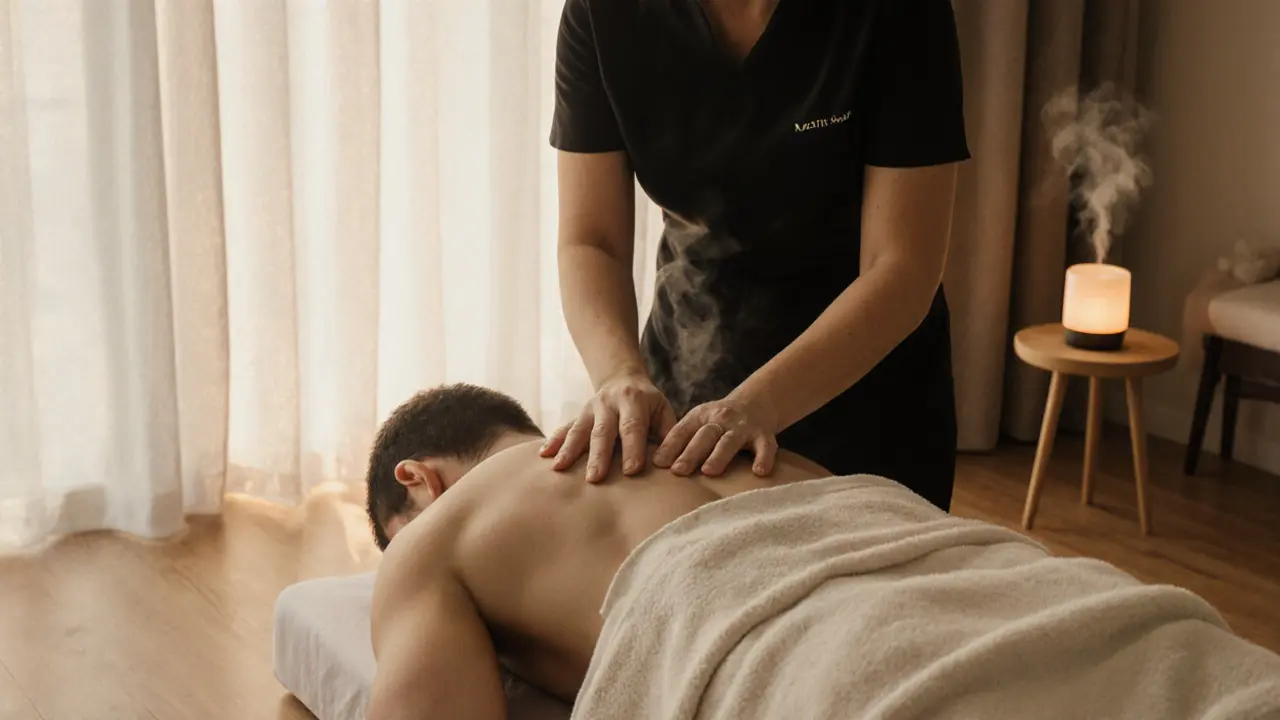You’ve heard the stories: deep tissue massage leaves you sore for days, feels like someone’s using your muscles as a punching bag, or worse - it’s just plain unbearable. But what if I told you that pain isn’t the point? That the discomfort you feel isn’t a sign it’s working, but a signal to slow down? If you’re thinking about trying deep tissue massage in Dubai, you’re not alone. Thousands of locals and expats book sessions every month, hoping to melt away chronic back pain, stiff shoulders, or stress that won’t quit. But the fear of pain holds a lot of people back. Let’s cut through the myths and tell you exactly what to expect.
Is Deep Tissue Massage Supposed to Hurt?
No. Not really. And that’s the biggest misunderstanding out there.
Deep tissue massage isn’t about enduring pain to get results. It’s about applying focused pressure to reach layers of muscle and connective tissue that are tight, knotted, or stuck from years of sitting at a desk, carrying kids, or running through Dubai’s heat. The goal? To break up adhesions and restore movement - not to make you wince.
Think of it like cleaning a clogged drain. You don’t blast it with a hammer. You use the right tool, steady pressure, and patience. Same with your muscles. If your therapist is digging in so hard you’re screaming, they’re not being effective - they’re being aggressive. Real deep tissue work should feel like a strong, deep stretch. A ‘good hurt’ - the kind you feel when you finally unlock a tight hip after months of stiffness. Not the kind that makes you want to jump off the table.
What Does Deep Tissue Massage Actually Do?
It’s not just a fancy rubdown. Deep tissue massage targets the deeper layers of muscle and fascia - the web of connective tissue that wraps around every muscle, bone, and organ in your body. When you sit all day in an office chair or carry heavy bags through the mall in Mall of the Emirates, that fascia gets sticky. Muscles shorten. Blood flow slows. That’s when pain, stiffness, and even headaches creep in.
Deep tissue massage uses slow, deliberate strokes and finger pressure to peel those layers apart. It’s not random. Therapists follow muscle fibers, find trigger points (those super-tight knots), and apply pressure just enough to release them without causing damage. Studies from the Journal of Clinical Psychiatry show it can reduce chronic lower back pain by up to 40% after just 10 sessions. People in Dubai who work long hours in air-conditioned towers or commute through rush hour traffic often report better sleep, fewer migraines, and more energy after a few sessions.
What You’ll Feel During a Session
Let’s walk through what actually happens on the table.
You’ll lie face down or on your side, covered with a towel. The therapist will start with lighter strokes to warm up your muscles - like preheating an oven. Then, they’ll move to deeper pressure. You might feel a burning or aching sensation - especially in areas like your lower back, shoulders, or IT bands. That’s normal. But if it turns sharp, shooting, or makes you gasp uncontrollably, speak up. A good therapist will adjust immediately.
Some people describe it as a ‘deep pressure massage’ - not painful, but intense. Others say it feels like someone is kneading dough with their thumbs. You might feel a little sore the next day, like after a tough workout. That’s called delayed onset muscle soreness (DOMS), and it’s mild. It fades in 24-48 hours. If you’re bruised or in real pain for days? That’s not normal. That’s too much.
One client I’ve worked with, a 42-year-old project manager from the UK, came in with constant neck pain from Zoom calls. After her first session, she said: “It felt like my muscles were being pulled apart - but in a way that made sense. I didn’t cry. I didn’t beg. I just breathed.” That’s the sweet spot.

Who Should Avoid Deep Tissue Massage?
Not everyone should get this treatment - and that’s okay.
- If you have recent injuries, fractures, or open wounds - wait until you’re healed.
- If you’re pregnant, especially in the first trimester, stick with prenatal massage. Deep pressure can be risky.
- If you have blood clotting disorders, osteoporosis, or are on blood thinners, talk to your doctor first.
- If you have severe arthritis, fibromyalgia, or autoimmune conditions, deep pressure might worsen inflammation. Lighter techniques like myofascial release or Swedish massage are better.
And if you’re just looking to relax? Skip deep tissue. Go for a Swedish massage. It’s gentler, uses long flowing strokes, and is perfect for stress relief without the intensity.
Deep Tissue vs. Swedish Massage in Dubai
| Feature | Deep Tissue Massage | Swedish Massage |
|---|---|---|
| Pressure | Strong, focused, slow | Light to medium, rhythmic |
| Goal | Release chronic tension, fix muscle knots | Relaxation, improve circulation |
| Best For | Athletes, desk workers, chronic pain sufferers | Stress relief, first-timers, general wellness |
| Pain Level | Moderate to intense (shouldn’t be sharp) | Minimal to none |
| Duration of Soreness | 1-2 days | None |
| Typical Cost in Dubai | AED 250-450 per hour | AED 200-350 per hour |
Most spas in Dubai - from The Ritz-Carlton in Jumeirah to local clinics in Al Barsha - offer both. The key? Know what you’re after. If you want to feel like you’ve been hit by a truck and then magically better, go deep tissue. If you want to unwind after a long flight from London or a weekend of shopping at Dubai Mall, choose Swedish.
How to Find a Good Deep Tissue Massage in Dubai
Not all massage therapists are created equal. In Dubai, you’ll find everything from luxury hotel spas to tiny clinics in residential buildings. Here’s how to pick wisely:
- Look for licensed therapists - check if they’re certified by the Dubai Health Authority (DHA). You can verify this online.
- Read reviews on Google or TripAdvisor. Look for mentions of “communication,” “pressure adjustment,” and “no pain after.” Avoid places with 1-star reviews saying “it hurt too much.”
- Ask if they specialize in deep tissue. Some therapists do it as an add-on. Others train for years in myofascial release and trigger point therapy.
- Try a 60-minute session first. Don’t jump into 90 minutes unless you’ve done it before.
- Book with someone who asks you questions: “Where do you feel the tightest?” “Does this feel okay?” That’s a sign they care about your experience.
Some trusted spots in Dubai include Body Therapy Dubai (Al Quoz), The Spa at Address Downtown, and Holistic Health Center in JLT. But don’t just pick the most expensive one. The best therapist isn’t always the one with the most candles.

What to Do After Your Session
Don’t just walk out and head back to your office.
- Drink water. Lots of it. Deep tissue massage releases toxins from your muscles. Hydration helps flush them out.
- Take it easy. Avoid intense workouts for 24 hours. A gentle walk is fine.
- Apply ice if you’re sore. Not heat - heat can increase inflammation.
- Stretch gently. Focus on the areas you worked on - shoulders, lower back, hamstrings.
- Wait 48 hours before your next deep tissue session. Your muscles need time to recover.
One client, a fitness trainer from Canada, said: “I used to think I needed to be wrecked to be fixed. Then I realized - I was wrecking myself. Now I schedule deep tissue every 3 weeks, and I feel stronger, not broken.”
Frequently Asked Questions
Does deep tissue massage really get rid of knots?
Yes - but not always in one session. Knots, or trigger points, are areas where muscle fibers have tightened and stuck together. Deep tissue massage breaks them apart with sustained pressure. It’s like untangling a knot in a rope. Sometimes you need a few tugs. After 3-5 sessions, most people notice significant improvement. Consistency matters more than intensity.
Why do I feel tired after a deep tissue massage?
It’s your body processing the release of tension and toxins. Deep tissue work stimulates your nervous system and increases blood flow, which can be draining. Think of it like a workout. You’re not weak - you’re healing. Rest, hydrate, and avoid caffeine or alcohol right after. Most people feel energized within 24 hours.
Can deep tissue massage cause injury?
It can - if done incorrectly. Too much pressure, wrong technique, or working on inflamed or injured tissue can cause bruising, nerve irritation, or even muscle strain. That’s why choosing a licensed, experienced therapist is critical. Always communicate during the session. If it hurts too much, say so. A good therapist will never ignore your feedback.
How often should I get a deep tissue massage?
For chronic pain or tightness, once every 2-4 weeks is ideal. If you’re using it for maintenance - say, after a big event or long travel - once a month works. Don’t go weekly unless you’re an athlete or have a specific condition under a therapist’s guidance. Your muscles need recovery time.
Is deep tissue massage worth the cost in Dubai?
If you suffer from persistent pain, poor posture, or stress-related tension - yes. Compared to physical therapy or chiropractic visits, it’s often more affordable and accessible. Many people find it reduces their need for painkillers or doctor visits. Think of it as preventive care. Paying AED 300 every few weeks to avoid a year of back pain? That’s a smart investment.
Final Thought: Pain Isn’t Progress
Deep tissue massage isn’t a torture test. It’s a tool - one that can bring real relief if used right. You don’t need to suffer to heal. The best results come from communication, consistency, and care - not brute force.
If you’ve been avoiding it because you think it’s supposed to hurt - rethink it. Find a therapist who listens. Book a session. Try it with an open mind. And if it feels wrong? Speak up. You’re in control. Your body knows what’s too much - even if your mind doesn’t.






